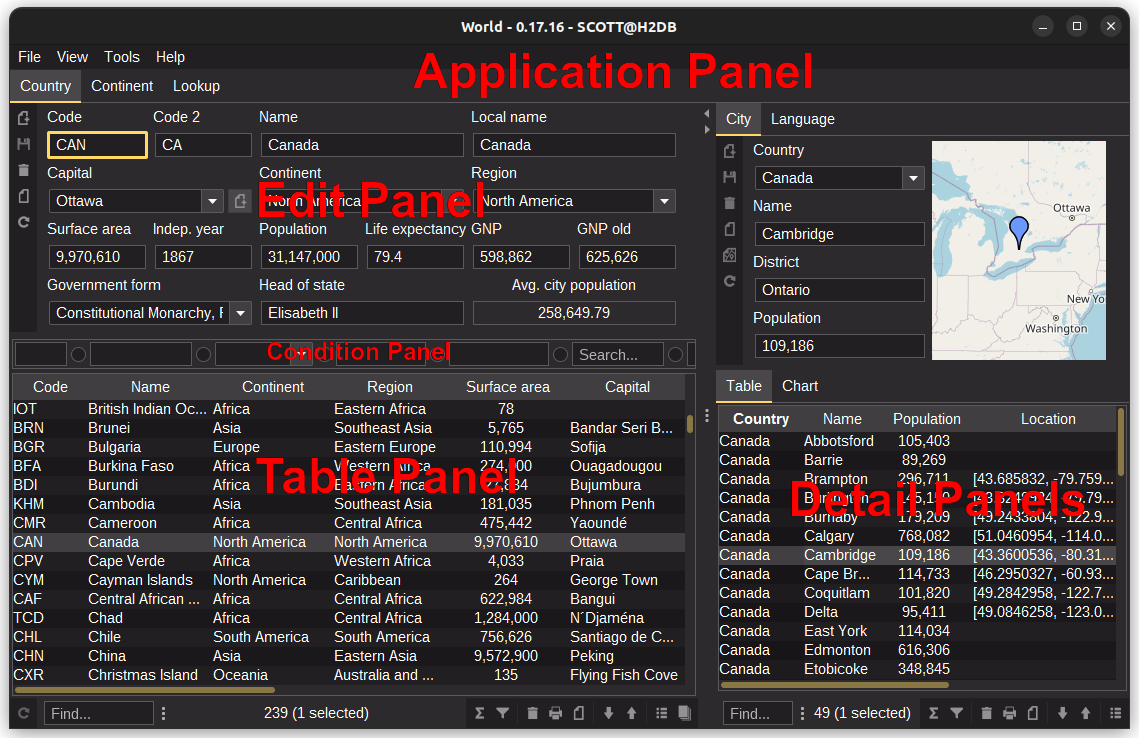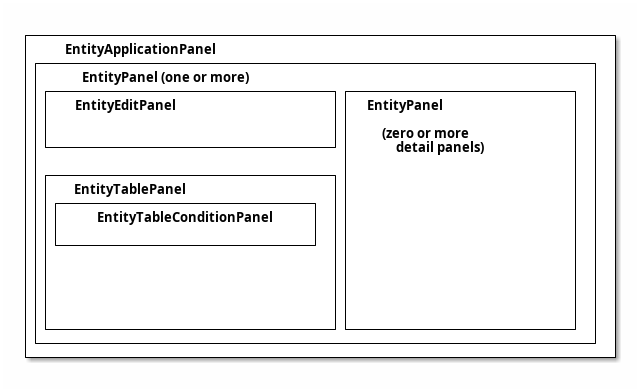1. Features
-
Lightweight client with a simple synchronous event model
-
Provides a practically mouse free user experience
-
Graceful handling of network outages and server restarts
-
Clear separation between model and UI
-
Easy to use load testing harness provided for application models
-
UI data bindings for most common components provided by the framework
-
Implementing data bindings for new components is made simple with building blocks provided by the framework.
-
The default UI layout is a simple and intuitive “waterfall” master-detail view
-
Extensive searching and filtering capabilities
-
Flexible keyboard-centric UI based on tab and split panes, detachable panels and toolbars
-
Detailed logging of client actions
3. Architecture
3.3. Assembly
3.3.1. EntityModel
/**
* Creates a SwingEntityModel based on the {@link Artist#TYPE} entity
* with a detail model based on {@link Album#TYPE}
* @param connectionProvider the connection provider
*/
static SwingEntityModel artistModel(EntityConnectionProvider connectionProvider) {
// create a default edit model
SwingEntityEditModel artistEditModel =
new SwingEntityEditModel(Artist.TYPE, connectionProvider);
// create a default table model, wrapping the edit model
SwingEntityTableModel artistTableModel =
new SwingEntityTableModel(artistEditModel);
// create a default model wrapping the table model
SwingEntityModel artistModel =
new SwingEntityModel(artistTableModel);
// Note that this does the same as the above, that is, creates
// a SwingEntityModel with a default edit and table model
SwingEntityModel albumModel =
new SwingEntityModel(Album.TYPE, connectionProvider);
artistModel.addDetailModel(albumModel);
return artistModel;
}3.3.2. EntityPanel
/**
* Creates a EntityPanel based on the {@link Artist#TYPE} entity
* with a detail panel based on {@link Album#TYPE}
* @param connectionProvider the connection provider
*/
static EntityPanel artistPanel(EntityConnectionProvider connectionProvider) {
// create the EntityModel to base the panel on (calling the above method)
SwingEntityModel artistModel = artistModel(connectionProvider);
// the edit model
SwingEntityEditModel artistEditModel = artistModel.editModel();
// the table model
SwingEntityTableModel artistTableModel = artistModel.tableModel();
// the album detail model
SwingEntityModel albumModel = artistModel.detailModel(Album.TYPE);
// create a EntityEditPanel instance, based on the artist edit model
EntityEditPanel artistEditPanel = new EntityEditPanel(artistEditModel) {
@Override
protected void initializeUI() {
createTextField(Artist.NAME).columns(15);
addInputPanel(Artist.NAME);
}
};
// create a EntityTablePanel instance, based on the artist table model
EntityTablePanel artistTablePanel = new EntityTablePanel(artistTableModel);
// create a EntityPanel instance, based on the artist model and
// the edit and table panels from above
EntityPanel artistPanel = new EntityPanel(artistModel, artistEditPanel, artistTablePanel);
// create a new EntityPanel, without an edit panel and
// with a default EntityTablePanel
EntityPanel albumPanel = new EntityPanel(albumModel);
artistPanel.addDetailPanel(albumPanel);
return artistPanel;
}3.4. Full Example
Show code
package is.codion.framework.demos.chinook.tutorial;
import is.codion.common.db.database.Database;
import is.codion.common.user.User;
import is.codion.framework.db.EntityConnectionProvider;
import is.codion.framework.db.local.LocalEntityConnectionProvider;
import is.codion.framework.demos.chinook.domain.Chinook.Album;
import is.codion.framework.demos.chinook.domain.Chinook.Artist;
import is.codion.framework.demos.chinook.domain.impl.ChinookImpl;
import is.codion.swing.framework.model.SwingEntityEditModel;
import is.codion.swing.framework.model.SwingEntityModel;
import is.codion.swing.framework.model.SwingEntityTableModel;
import is.codion.swing.framework.ui.EntityEditPanel;
import is.codion.swing.framework.ui.EntityPanel;
import is.codion.swing.framework.ui.EntityTablePanel;
/**
* When running this make sure the chinook demo module directory is the
* working directory, due to a relative path to a db init script
*/
public final class ClientArchitecture {
// tag::entityModel[]
/**
* Creates a SwingEntityModel based on the {@link Artist#TYPE} entity
* with a detail model based on {@link Album#TYPE}
* @param connectionProvider the connection provider
*/
static SwingEntityModel artistModel(EntityConnectionProvider connectionProvider) {
// create a default edit model
SwingEntityEditModel artistEditModel =
new SwingEntityEditModel(Artist.TYPE, connectionProvider);
// create a default table model, wrapping the edit model
SwingEntityTableModel artistTableModel =
new SwingEntityTableModel(artistEditModel);
// create a default model wrapping the table model
SwingEntityModel artistModel =
new SwingEntityModel(artistTableModel);
// Note that this does the same as the above, that is, creates
// a SwingEntityModel with a default edit and table model
SwingEntityModel albumModel =
new SwingEntityModel(Album.TYPE, connectionProvider);
artistModel.addDetailModel(albumModel);
return artistModel;
}
// end::entityModel[]
// tag::entityPanel[]
/**
* Creates a EntityPanel based on the {@link Artist#TYPE} entity
* with a detail panel based on {@link Album#TYPE}
* @param connectionProvider the connection provider
*/
static EntityPanel artistPanel(EntityConnectionProvider connectionProvider) {
// create the EntityModel to base the panel on (calling the above method)
SwingEntityModel artistModel = artistModel(connectionProvider);
// the edit model
SwingEntityEditModel artistEditModel = artistModel.editModel();
// the table model
SwingEntityTableModel artistTableModel = artistModel.tableModel();
// the album detail model
SwingEntityModel albumModel = artistModel.detailModel(Album.TYPE);
// create a EntityEditPanel instance, based on the artist edit model
EntityEditPanel artistEditPanel = new EntityEditPanel(artistEditModel) {
@Override
protected void initializeUI() {
createTextField(Artist.NAME).columns(15);
addInputPanel(Artist.NAME);
}
};
// create a EntityTablePanel instance, based on the artist table model
EntityTablePanel artistTablePanel = new EntityTablePanel(artistTableModel);
// create a EntityPanel instance, based on the artist model and
// the edit and table panels from above
EntityPanel artistPanel = new EntityPanel(artistModel, artistEditPanel, artistTablePanel);
// create a new EntityPanel, without an edit panel and
// with a default EntityTablePanel
EntityPanel albumPanel = new EntityPanel(albumModel);
artistPanel.addDetailPanel(albumPanel);
return artistPanel;
}
// end::entityPanel[]
public static void main(String[] args) {
// Configure the database
Database.DATABASE_URL.set("jdbc:h2:mem:h2db");
Database.DATABASE_INIT_SCRIPTS.set("src/main/sql/create_schema.sql");
// initialize a connection provider, this class is responsible
// for supplying a valid connection or throwing an exception
// in case a connection can not be established
EntityConnectionProvider connectionProvider =
LocalEntityConnectionProvider.builder()
.domain(new ChinookImpl())
.user(User.parse("scott:tiger"))
.build();
EntityPanel artistPanel = artistPanel(connectionProvider);
// lazy initialization
artistPanel.initialize();
// fetch data from the database
artistPanel.model().tableModel().refresh();
// uncomment the below line to display the panel
// displayInDialog(null, artistPanel, "Artists");
connectionProvider.close();
}
}

